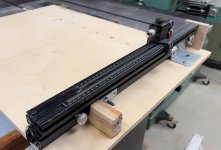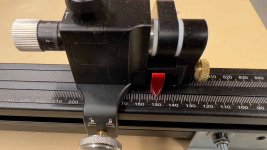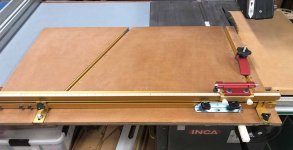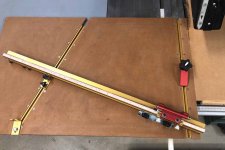Decades ago, I built my first crosscut sled by putting a piece of ⅛" masonite between the head and bar of my miter gauge. That didn't last long (hole for the miter head pivot wore quickly), so I rebuilt it with ¼" masonite. That necessitated me adding a front fence for support, and I added a block with a wood screw as a 90º stop. That wasn't so great either as my miter bar had a tiny bit of play. This is for an Inca 2100, so my miter bar isn't the standard size.
Then, several years ago I got ambitious and built a whole new crosscut sled from ½" MDF with a ⅛" whiteboard under lamination. I made my own runner from HDPE, and I used a simple "L" bracket from Incra (not Inca!) on a ¼" steel peg for the head that attached to one of Incra's fences that takes their dual stop block. I also used 2 of Incra's T-slot panel connectors to provide slots for both hold-downs and to secure the far end of the fence as it pivoted. The whiteboard lamination saved me the trouble of routing under slots for the Incra connectors and let me have a ⅝" thick sled instead of ¾".
I didn't know it at the time, but I had made an overly complicated Dubby. Many people don't know about the
Dubby, but they do know about
Rocker's cross-cut sled clone/copy.
Here's what it looked like:
[attachimg=4]
And when cutting angles:
[attachimg=5]
And a close-up of the left side 90º stop:
[attachimg=6]
That sled was pretty good for many years. I liked the Incra fence with stop block as I could dial in cuts to the mm (although at the time these photos were taken I was still using lousy Imperial) with darn good accuracy and excellent repeatability. Just the other day I added a micro-adjuster to the stop block after doing the same on my miter saw.
Then I got an idea for a way more accurate angle sled. I started working on that, and ended up modifying my sled to accommodate my new design. In the process of designing my new super-duper angle-master sled, I bought a couple different miter gauge fences to try out. Turns out they're not as compatible with my design as the Incra. Well, it's all still under development, but the unfortunate side-effect of Frankenstein-ing my sled is that I no longer had a good standard cross-cut sled.
But, instead of building yet another complicated sled, I decided to go somewhat simpler. I decided to not worry about other than 90º for now, but had liked having a real fence with flip stop, and I now had two other aluminum fences with flip stops just sitting around. So, I built a new cross-cut sled around the fence for the Hongdui miter gauge that some people rave about.
[attachimg=1]
As you can see, it's still a one-side sled. I don't like two-sided sleds as then you have to deal with the center getting cut up from blade tilt use. Since my blade tilts right, that doesn't affect this sled. It's also why my rip fence goes to the left, whereas most people run it to the right.
My miter slots are 20mm wide. I bought some 1mm thick HDPE tape and put that on one side of the aluminum miter bar, then used the wheel thingies to adjust the fit. It's kind of nice having HDPE/plastic on both sides of the miter bar where they contact the slot. I used ½" baltic birch for the base. Much lighter than the MDF I was using before. I didn't bother with the panel connectors, and this doesn't have T-slots.
I used an L-bracket that I had to re-drill to line up with the location of the T-slot on the back of the Hongdui fence, and bolted through the top into one of the threaded holes on the miter bar. Since the L-bracket wasn't perfectly square (actually, not close at all), I had to shim where it attaches to the aluminum fence. I also bolted through the sled bottom into the miter bar at every threaded location. I had also drilled out holes so I could access the adjustable wheel thingies without taking the sled apart.
Then I put a stop block with a pan-head wood screw at the left.
[attachimg=2]
You can't see the wood screw, sorry. If you go back to the first photo, you'll see there's another horizontal L bracket from the stop block to the back of the fence. This actually holds the fence against the wood screw coming out of the stop block.
At the cutting side of the fence, I added a piece of MDF for a sacrificial end. if you look closely, you can see there's a 10mm domino coming out the back of the MDF, and that's how the MDF is bolted to the fence.
The Hongdui fence is pretty nice in most ways, but has some quirks. First, the main ruler on top is not adjustable side to side. Instead, there's a brass screw to move the red cursor:
[attachimg=3]
The cursor is nicely machined with sharp edges, and I used a white fill-in marker on those edges to make the point visible. EDIT: Turns out the secondary ruler for the telescoping fence use is adjustable, so I've removed my comments on that.
Now, while the cursor is adjustable, it's got a limited range. As a result, I ended up attaching a 10mm block to the stop block so that I could position the fence far enough from the blade to have the MDF not fall apart when cut. The flip stop has threaded holes for 4mm bolts, so that worked out pretty easily.
After building the sled, it was time to align it. I removed the sacrificial fence end, then cut off the right edge of the sled with the blade at 90º tilt. Then took my best square and adjusted the fence to be perpendicular to the cut edge. This was done via the stop block wood screw. Tightened everything down and did a 5-cut.
I was off by 0.41mm over about 500mm (that's better than 0.012º so my square and setup with it is quite good). Ran the numbers through the calculator and adjusted the wood screw protrusion using a digital caliper, then re-tightened and re-5-cut.
The two ends of the off-cut were off by 0.01mm. I couldn't believe it, so I remeasured and got a 0.02mm different. My thumb pressure on the caliper's wheel mattered. That was astounding. I then cut a piece to a 150mm length via the cursor and checked that with the caliper and it read 150.3mm. Done.
I was going to do a few other things in the shop, but decided to end the day on this high note. I've done many 5-cut setups but never got it dialed in this good, and on the first try!







